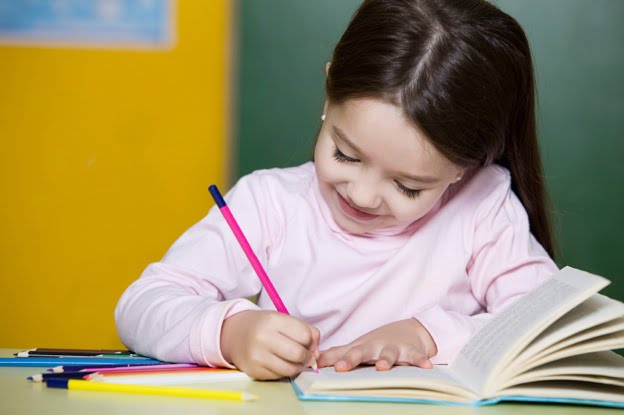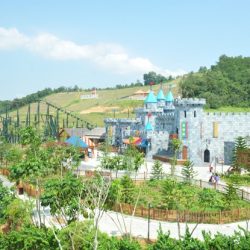SingaporeMotherhood | Preschooler & Up
September 2012
Let Children Learn How To Learn

Within 30 minutes, Nicole Chang had completed her multiplication homework and made a chart on her responsibilities at home for her upcoming show-and-tell session at school. After this she read a library book until it was time for bed.
Her father, Thio Gunawan, has taught her to enjoy learning. He dedicates an hour every evening to find out what she has learned at school and sits with her as she goes through her spelling, Chinese recitation, and electone practice. The six-and-a-half year old student, who attends a local Montessori school, needs no urging to do her work. For her, learning is fun, as it should be.
Childhood learning is a newsworthy topic at any time. But right now, it is red hot.
First, PM Lee in his National Day Rally this August encouraged learning through play. “No homework is not a bad thing. It is good for young children to play and to learn through play,” he said. Coupled with that juicy nugget was a call to reform preschool education and facilitate a better work-life-balance for parents.
To Andy Lee, a father of three children aged between three and seven, no homework is ideal: “Kids should have a healthy childhood. Too much school work really stresses them out.”
Armando Tjoa wants his children to develop values and believes that less homework will give children more time to grow in this area. “Lesser homework is good so children have a chance to build their personal character instead, which academic work can’t accomplish,” the father of two girls said.
Less homework and more play sounds ideal. However, to instill a sense of discipline and accomplishment without these means that the teaching-and-learning process must be reinvented. Similarly, the method through which a student’s capabilities are gauged.
Continuous assignments – as an alternative to examinations – are hailed as a consistent and less stressful method of assessment. However, these are not without their own set of problems. Every piece of homework, every project, and every show-and-tell session could become a potential cause of distress.
As parents, we are in the best position to teach our children how to manage their work and enjoy doing them. As Education Minister Heng Swee Keat wrote in a commentary for Today newspaper earlier this month, parents are a child’s first teachers. Not hot-housing our children, giving them room to explore and make mistakes, would be more conducive to having happier school-going children.
What we’re seeking now is a balance between work and play. Talk has centered around the abolishment of schooling banding, homework, and the PSLE. However, no concrete alternatives have been suggested. While the powers-that-be continue to strategise, let’s take a look at how the education system in some Asian countries is helping their children to learn.

Hong Kong: Developing individual potential
Whole-day primary schooling was introduced in 1993. Both schools and parents support this as it promotes all-round education for the students. Compared to half-day primary school operation, whole-day schooling means schools have the opportunity to provide a better learning environment and a more diversified range of learning activities for the students. All students learn one musical instrument as an extracurricular activity from Primary 1. Weaker students are given extra tuition in school, free of charge.
By loosening the previously tight learning schedules, the schools are also empowered to design a more flexible curriculum. Typically, a student spends at least seven hours at school, starting from 8 or 8.30 in the morning. The school day includes two recesses of 20 minutes each and a one hour lunch break. The longer school hours also facilitate field trips, guidance or counselling services, remedial teaching, and longer periods for learning certain subjects.
South Korea: Empowering the child
The South Korean education system, with its longer school days and after-school programmes, was lauded by US President Obama in his State of The Union address in 2011. He brought attention to the role of teachers, saying that “after our parents, the biggest impact on a child’s success comes from the man or woman at the front of the classroom”. In South Korea, he added, teachers are known as “nation builders”.
Accordingly, teachers and schools in South Korea have been granted increased autonomy. With this they have revised curriculums to reduce study loads while developing practical skills in children. A “creative management school” programme, currently in use in 25 per cent of schools in the country, aims to provide “creativity and character education”.
The country, which has 46,159 school-going children from varied family backgrounds, has also successfully implemented multicultural education. A three-year project at Miwon Primary school offered support classes and extra language courses for students of multicultural backgrounds. All students also celebrated multi culture days and produced movies based on multicultural topics.
Taiwan: Consistent learning from young
An Early Childhood Education and Care Act established in January this year merges nursery and kindergarten into a single entity called “preschool”. Children between two and six years old are given complete and thorough education and care until it is time for to start their nine years of compulsory education. Although preschool is not compulsory, the act guarantees consistent education and care at different institutions.
All content from this article, including images, cannot be reproduced without credits or written permission from SingaporeMotherhood.
Follow us on Facebook, Instagram, and Telegram for the latest article and promotion updates.





